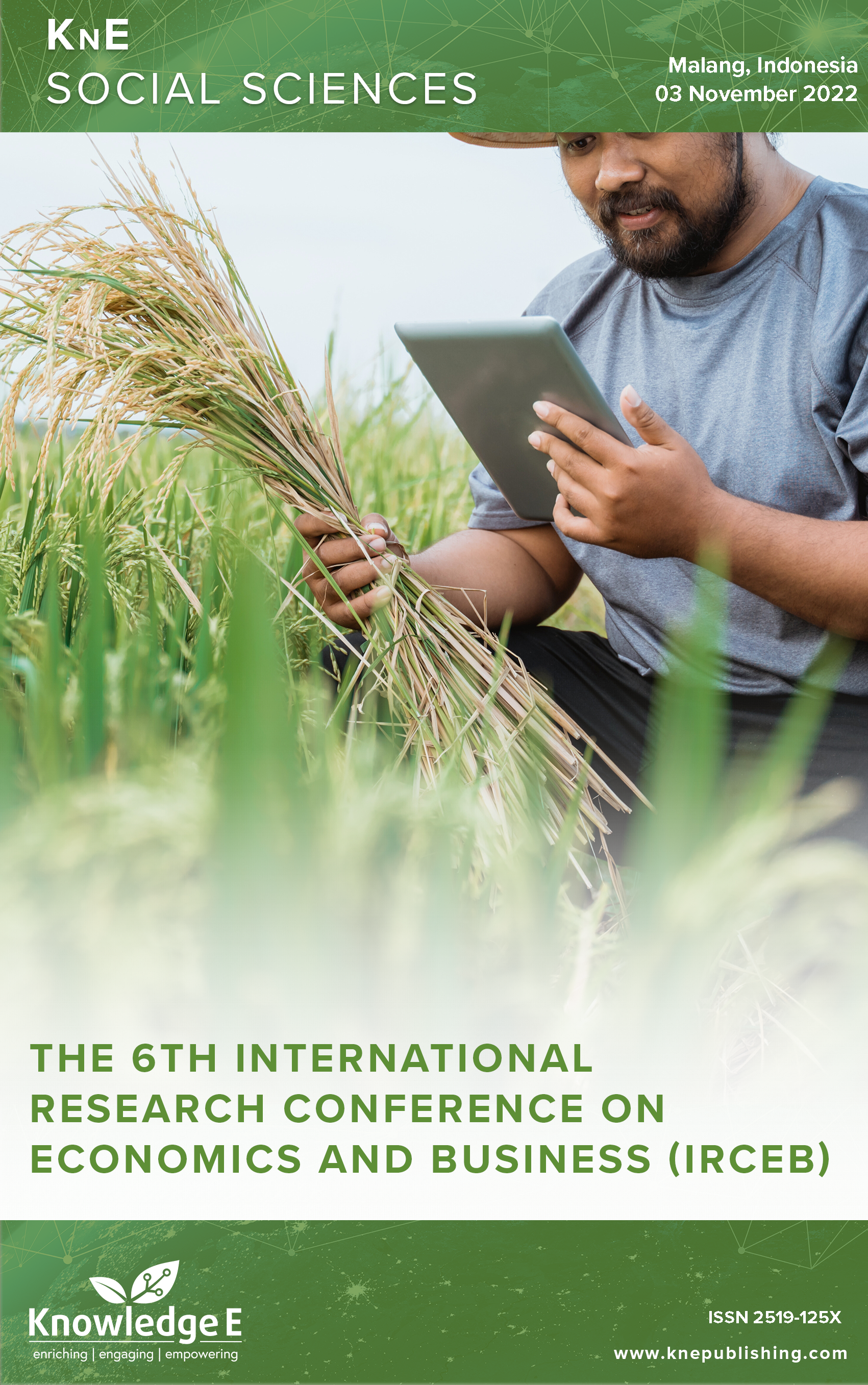Blue Waqf Framework for Blue Forest Sustainability: A Conceptual Framework
DOI:
https://doi.org/10.18502/kss.v9i4.15088Abstract
Blue forests are areas that protect the coastline from flooding and erosion. They harbor wildlife and provide a sustainable livelihood for communities. One of the blue forest types is mangrove forest. Indonesia has the most expansive mangrove forest area in Southeast Asia, but nearly 25% has been deforested. Maintaining the sustainability of mangrove forests is one of the sustainable development goals (SDG) 14. Therefore, to achieve this goal, financing is needed to support the needs in maintaining the sustainability of mangrove forests. This paper is a conceptual framework that provides an Islamic social finance-based funding model for the blue forest sector. This program is called Blue Waqf. In order to implement this program, Indonesian Waqf Board and registered nazir are needed as the program’s coordinators. In addition, a colossal campaign needs to be conducted. The involvement of the surrounding community as a social adaptor is also vital. Last, waqf management through blue waqf requires protection from takaful/project guarantees. It has to be done to minimize the economy. The impact will be sustainable for the economy, society, and the environment. The profits obtained from blue waqf will be distributed to beneficiaries.
Keywords: Blue Waqf, sustainable, Blue Forest, conceptual framework
References
Abbasi MZ. The classical Islamic Law of Waqf: A concise introduction. Arab Law Q. 2012;26(2):121–153. DOI: https://doi.org/10.1163/157302512X629124
Abdullah M. Waqf, sustainable development goals (SDGs) and maqasid al-shariah. Int J Soc Econ. 2018;45(1):158–172. DOI: https://doi.org/10.1108/IJSE-10-2016-0295
ADB. Renewable energy tariffs and incentives in Indonesia: Review and recommendations. 2020.
Akhtar MR. Towards an Islamic approach for environmental balance. Islam Econ Stud. 1996;3(2):57–77.
Ali KM, Kassim S. Development of Waqf forest in Indonesia: The SWOT- ANP analysis of Bogor Waqf forest program by Bogor Waqf Forest Foundation [ Journal of Tropical Forest Management]. Jurnal Manajemen Hutan Tropika. 2021;27(2):89–99. DOI: https://doi.org/10.7226/jtfm.27.2.89
Turisno BE, Suharto R, Priyono EA. Peran Serta Masyarakat Dan Kewenangan Pemerintah Dalam Konservasi Mangrove Sebagai Upaya Mencegah ROB Dan Banjir Serta Sebagai Tempat Wisata. Masalah-Masalah Hukum. 2018;47(4):479–497. DOI: https://doi.org/10.14710/mmh.47.4.2018.479-497
Bagader AA, El Sabbagh AT, Al-Glayand MA, Samarrai MY, Llewellyn OA. Environmental Protection in Islam. IUCN Environ Policy Law Pap. 1994;:20.
Bakar MA, Ahmad S, Salleh AD, Salleh MF. Waqf and sustainable development goals (SDGs): A critical review from Malaysia Perspective. Journal of Critical Reviews. 2020;7(13):2362–2385.
Budiman MA. The role of Waqf for environmental protection in Indonesia. Aceh Development International Conference. 2011. 880–889.
CAF World Giving Index 2018. 2019.
Duh AA. Religion’s role in development, ecology & climate change: An Islamic perspective. The Conference on the Role of Religion in Development-Focus on Ecology and Climate Change. 2010.
Eddy SM, Rasyid R, Iskha I, Andy M. Community-based mangrove forests conservation for sustainable fisheries. Jurnal Silvikultur Tropika. 2016;7(3):S42–S47.
Fattah M, Pudji P, Edi S. Nilai Manfaat Tidak Langsung Hutan Mangrove Pantai Cengkrong Kabupaten Trenggalek. Seminar Nasional Perikanan Dan Kelautan Berkelanjutan. 2018;II:172–175.
Foundations DG. The Waqf protecting the environment and forestry. Marvelous Pious Foundations (Waqfs) throughout. History (Lond). 2014;:34.
Friess DA. Ecotourism as a tool for mangrove conservation. Sumatra Journal of Disaster. Geography and Geography Education. 2017;1(1):24–35.
Ilman M, Wibisono I, Suryadiputr I. State of the Art Information on Mangrove Ecosystems in Indonesia. In Wetlands International-Indonesia Programme. Bogor. 2011.
Kahf M. The role of waqf in improving the ummah welfare. International Seminar on Waqf as a Private Legal Body. 2003.
Kamariah A, Said AM, Dasimah O. Community-based conservation in managing mangrove rehabilitation in Perak and Selangor. Procedia Soc Behav Sci. 2014;153:121–131. DOI: https://doi.org/10.1016/j.sbspro.2014.10.047
Kementerian Kelautan dan Perikanan. Kondisi Mangrove di Indonesia. 2022. Retrieved from kkp.go.id website: https://kkp.go.id/artikel/26393-sepanjang-2020- kkp-tanam-2-9-juta-batang-mangrove-untuk-pulihkan-ekosistem-pesisir
Listiana L, Alhabshi SM. Waqf and legacy of Altruism in Singapore: Challenges and development [ Jurnal Ekonomi Dan Bisnis Islam]. JEBIS. 2020;6(1):116–133. DOI: https://doi.org/10.20473/jebis.v6i1.19736
MA, Y F, SA. Forest-Based Tourism in Bangladesh: Status, Problems, And Prospects. TOURISMOS: An International Multidisciplinary Journal of Tourism. 2010;5(1):163–172.
Mutmainah LN, Taqwa KZ, Indrawan IW. Cash Waqf Linked Blue Sukuk (CWLBS) for sustainable marine ecosystem: A conceptual model. 2022. Retrieved from https://www.unep.org/
Osman AZ, Agyemang G. Privileging downward accountability in Waqf management. J Islamic Account Bus Res. 2020;11(3):533–554. DOI: https://doi.org/10.1108/JIABR-05-2017-0064
Purwanti P, Fattah M, Qurrata VA, Narmaditya BS. An institutional reinforcement model for the protection of mangroves sustainable ecotourism in Indonesia. Geo J Tour Geosites. 2021;35(2):471–479. DOI: https://doi.org/10.30892/gtg.35227-674
Purwanti P, Susilo E, Indrayani E. Household economic activities of coastal resource uusers’ community in Cengkrong Coastal Area, Prigi Bay, Trenggalek District. Russ J Agric Soc-Econ Sci. 2017;2(62). DOI: https://doi.org/10.18551/rjoas.2017-02.11
Purwanti P, Susilo E, Lestariadi RA. Mangrove forest management and mangrovebased business development opportunities in the Gulf of Prigi Trenggalek. International Journal of Social and Local Economic Governance. 2017;3(2).
Suwanno S, Nittiyar T, Nuttida S, Aurathai P. Potential of ecological resources and ecotourism destination management: A case study in Koh-Mak Community, Southern Thailand. PSAKU International Journal of Interdisciplinary Research. 2017;6(2):9–21. DOI: https://doi.org/10.12778/235108618X15452373186146
Thaker MA, Amin MF, Thaker HM, Khaliq A, Pitchay AA, Fauziyyah NE, et al. Waqf land and Sukuk framework for waste disposal management–a conceptual study. Labuan E-Journal of Muamalat and Society. 2022;16:1–12.
UN Environment Programme. Mangrove in the Spotlight. 2017. Retrieved from www.unep.org website: https://www.unep.org/news-and-stories/story/mangrovesspotlight

